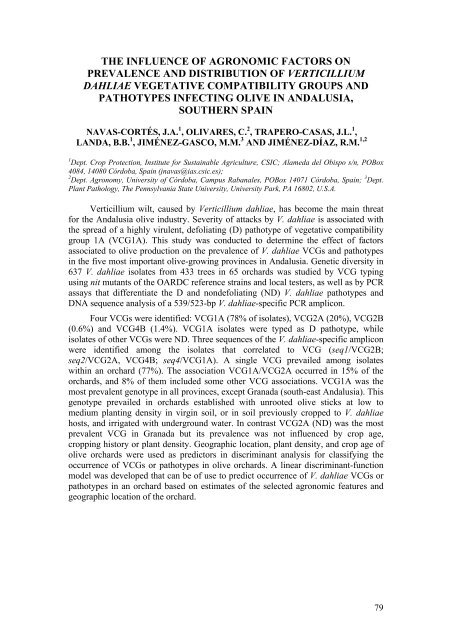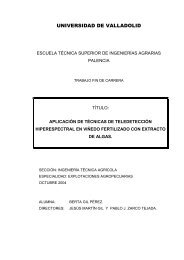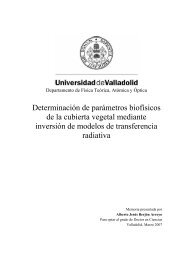10th INTERNATIONAL VERTICILLIUM SYMPOSIUM 16-20 ...
10th INTERNATIONAL VERTICILLIUM SYMPOSIUM 16-20 ...
10th INTERNATIONAL VERTICILLIUM SYMPOSIUM 16-20 ...
Create successful ePaper yourself
Turn your PDF publications into a flip-book with our unique Google optimized e-Paper software.
THE INFLUENCE OF AGRONOMIC FACTORS ONPREVALENCE AND DISTRIBUTION OF <strong>VERTICILLIUM</strong>DAHLIAE VEGETATIVE COMPATIBILITY GROUPS ANDPATHOTYPES INFECTING OLIVE IN ANDALUSIA,SOUTHERN SPAINNAVAS-CORTÉS, J.A. 1 , OLIVARES, C. 2 , TRAPERO-CASAS, J.L. 1 ,LANDA, B.B. 1 , JIMÉNEZ-GASCO, M.M. 3 AND JIMÉNEZ-DÍAZ, R.M. 1,21 Dept. Crop Protection, Institute for Sustainable Agriculture, CSIC; Alameda del Obispo s/n, POBox4084, 14080 Córdoba, Spain (jnavas@ias.csic.es);2 Dept. Agronomy, University of Córdoba, Campus Rabanales, POBox 14071 Córdoba, Spain; 3 Dept.Plant Pathology, The Pennsylvania State University, University Park, PA <strong>16</strong>802, U.S.A.Verticillium wilt, caused by Verticillium dahliae, has become the main threatfor the Andalusia olive industry. Severity of attacks by V. dahliae is associated withthe spread of a highly virulent, defoliating (D) pathotype of vegetative compatibilitygroup 1A (VCG1A). This study was conducted to determine the effect of factorsassociated to olive production on the prevalence of V. dahliae VCGs and pathotypesin the five most important olive-growing provinces in Andalusia. Genetic diversity in637 V. dahliae isolates from 433 trees in 65 orchards was studied by VCG typingusing nit mutants of the OARDC reference strains and local testers, as well as by PCRassays that differentiate the D and nondefoliating (ND) V. dahliae pathotypes andDNA sequence analysis of a 539/523-bp V. dahliae-specific PCR amplicon.Four VCGs were identified: VCG1A (78% of isolates), VCG2A (<strong>20</strong>%), VCG2B(0.6%) and VCG4B (1.4%). VCG1A isolates were typed as D pathotype, whileisolates of other VCGs were ND. Three sequences of the V. dahliae-specific ampliconwere identified among the isolates that correlated to VCG (seq1/VCG2B;seq2/VCG2A, VCG4B; seq4/VCG1A). A single VCG prevailed among isolateswithin an orchard (77%). The association VCG1A/VCG2A occurred in 15% of theorchards, and 8% of them included some other VCG associations. VCG1A was themost prevalent genotype in all provinces, except Granada (south-east Andalusia). Thisgenotype prevailed in orchards established with unrooted olive sticks at low tomedium planting density in virgin soil, or in soil previously cropped to V. dahliaehosts, and irrigated with underground water. In contrast VCG2A (ND) was the mostprevalent VCG in Granada but its prevalence was not influenced by crop age,cropping history or plant density. Geographic location, plant density, and crop age ofolive orchards were used as predictors in discriminant analysis for classifying theoccurrence of VCGs or pathotypes in olive orchards. A linear discriminant-functionmodel was developed that can be of use to predict occurrence of V. dahliae VCGs orpathotypes in an orchard based on estimates of the selected agronomic features andgeographic location of the orchard.79




